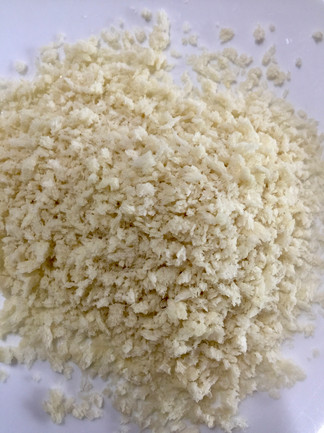Panko
- rosemary
- Nov 14, 2021
- 6 min read
"Invented by soldiers and cooked only with electrical currents, panko could be the most interesting baked good since sliced bread."
Aleksandra Bliszczyk - SBS
On the left, the real thing. On the right Woolworths Home Brand as photographed by me..
One of the wonderful things about writing this blog is how you might start out thinking you are going to write one thing, but along the way you come across other things you didn't know and it turns into something else. That's how the internet works isn't it? Because you never have the precisely right search term other things get thrown up - particularly, I have found if you search Google Images. So you go down a different path and that takes you onto something else, and before you know where you are, you are a long way from your starting point. A bit like how my brain - and probably everybody's - works too.
So yesterday I at last bought some panko crumbs from the supermarket - and true to my working class roots, I went for the cheapest, and Australian packet on offer, rather than the imported Japanese item - because we were cooking schnitzels with the grandchildren and I didn't have quite enough stale bread for the breadcrumb coating, I deliberately got the panko breadcrumbs because I thought it would be an opportunity see what all the fuss was about. I mean there's a lot of fuss about panko breadcrumbs. But aren't they just dried breadcrumbs thought I? It was a chance to investigate and to report, with perhaps a few recipes thrown in.
And sure - I have investigated panko breadcrumbs and have a few recipes - which I shall come to, but the thing that really surprised me was to learn about yōshoku, which means Western food. Apparently there are two Japanese cuisines washoku - traditional Japanese cuisine and yōshoku - Western food, although it's not really Western food, but western influenced food. It's very Japanese.
Yōshoku was born around 1868 when the Meiji dynasty was restored to rule Japan. Prior to this, for centuries and centuries, meat had been banned in Japan. As had relations with other countries. Japan was very isolationist, although there had been some 'offshore' trading posts. Buddhism was the religion and meat was banned from the Japanese diet, although not fish for some reason. However, in 1853 the Americans came with their warships intent on setting up trading treaties. The Japanese were overwhelmed by the advanced technologies of the westerners, and the Emperor was restored to the throne:
"to strengthen Japan against the threat of being colonized represented by the colonial powers of the day"
Now whilst I knew about the isolationism of Japan and the arrival of the Americans I had no idea that meat had been banned for consumption there. Apparently:
"the Emperor lifted the ban on red meat and promoted Western cuisine, which was viewed as the cause of the Westerners' greater physical size." Wikipedia
The term yōshuko was first coined a few years later in 1872, and now embraces a plethora of dishes that might, at first glance look like actual Western dishes, but which in fact are very Japanese and considered to be truly Japanese. There are restaurants in Japan which concentrate exclusively on yōshuko. It's true fusion cuisine - another one born of the clash of civilisations if you like, although it's actually a merger of civilisations, and more than two civilisations, not a clash. The trend continues so that today there is also mukokuseki which means 'no-nationality' cuisine. Rough Guides described it as a 'mish-mash' of world cooking styles, but when I looked into it I found that the term is more often assigned to anime and manga and that curiously blank kind of face that you find on the characters - ever so vaguely Japanese, but not really. So just translate that into food.
Yōshuko however, now has a repertoire of distinctly Japanese dishes, even if they are based on western ones: Here are a few examples, and I have to say the pork tonkatsu - the first one, is the only one that looks remotely tempting to me. The others are: Hambagu - yes based on hamburgers; Napolitan - derived from spaghetti Napolitana; kare raise - curry and rice - an even worse rendition of Indian curry than the British ones I think; and omurice - a rice stuffed omelette slathered with tomato ketchup. Not my thing at all, but interesting.

The pork tonkatsu brings us back to panko and another slight diversion to shokupan - the Japanese bread that is used in the making of panko breadcrumbs. It might look like your average white sliced supermarket bread, but it's not quite the same. Although if you are planning on making your own panko breadcrumbs, then supermarket sliced white is the way to go.

The website Chopstick Chronicles has a very detailed recipe for making shokupan, if you want to give it a go, but a quick description that comes from a Melbourne baker, Leo Lee might put you off:
“Shokupan has butter, milk and/or cream in the dough. This addition gives it its English name, milk bread, as well as a higher fat content compared to a typical white bread. It is also made with the yudane method, which is a water roux made by mixing a portion of the dough with hot water. The result is a soft interior with fluffy, slightly chewy texture and a thin fragrant crust.” Leo Lee
And I think there is sugar in the mix as well, so a slightly sweet bread.
And if you want to make proper panko breadcrumbs then you need the right bread. But:
"Anyone who’s tried making their own panko breadcrumbs will know it’s not worth the effort. Even after removing the crusts from a loaf of white bread, baking it whole, grating it and baking again, you may still be left with a pile of limp confetti or dry shale. In reality, the only way to produce panko’s light, rigid slivers is with electricity.
On a commercial scale, mounds of white-bread dough are tipped into deep, electrically charged metal trenches. The dough is zapped, effectively steaming it from the inside without exterior heat, yielding a crustless loaf that is then air-dried for 18 hours, pushed through a screen to form shards, and lightly toasted. This galvanic method is often attributed to Japanese soldiers in World War II, who baked bread outdoors without an oven." Aleksandra Bliszczyk - SBS

Which of course, won't stop endless food writers telling you how to make your own. Although even here, one writer couldn't resist telling you to use a specialist Japanese grater designed for grating daikon radish. She did have a useful tip though - freeze your bread before grating. Because to get the right flaky texture they virtually all suggest hand grating the bread rather than just chucking it into a food processor. She doesn't seem to have cut off the crusts though, and I thought that was a rule of panko breadcrumb making.
And I suspect the Australian and particularly the home brand offerings in your supermarket are (a) not made from the right bread, and (b) not made in the correct manner. And if you can buy a Japanese brand easily enough - Obento - in Woolworths, for a mere $2.00 a packet why would you not?
But then again are they that much superior? I'm afraid I cannot find a taste test answer to this, and I wouldn't know, but then again I probably would not be able to tell the difference. The Woolworths brand were certainly crunchy.

Here in Australia we seem to mostly use them for the katsu kind of cooking - crumbed things, like the schnitzels the grandchildren made for dinner last night. We had a half and half panko and 'ordinary' home-made breadcrumbs mixed with parsley and Parmesan for our coating. Not really hugely professional looking but tasty and every last crumb was eaten.
Sydney chef Kenny Takayama has these rules for panko-crumbing:
"Your egg must be well-beaten, or the crumb will peel off. The panko should be applied lightly and uniformly ... and don’t fry straight away, wrap [the tonkatsu] and rest it in the fridge. Take it out half an hour before deep-frying to bring it up to room temperature. When it’s cooked perfectly, the panko stands upright like lightning bolts sent from heaven."
Well I'm afraid we didn't rest our schnitzels in the fridge, but we did beat the eggs.
So here are some professional and rather more tempting looking samples of panko crumbed things from here and there - mostly Australia. Mushroom arancini from Christine Manfield; Tahini chicken schnitzel from Yotam Ottolenghi - so much fusion in this one; Shannon Bennett's Kewpie and panko fried chicken with crisp salad; Chicken katsu curry from Emma Knowles in Gourmet Traveller; Meera Sodha's Katsu curry with panko aubergines and pickled radishes; Pork tonkatsu sandwiches from Sydney's Café Oratnek (no recipe) and let's end with a sample from Japan of Kushikatsu - panko crumbed prawns. Just drool - there is no recipe.
I thought I was just going to say 'panko breadcrumbs, what's all the fuss about, ordinary breadcrumbs will do', but now, as with all things Japanese it's so much more complicated - and strange. And once again, all history and politics is there on your supermarket shelf.



































Comments